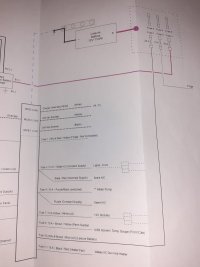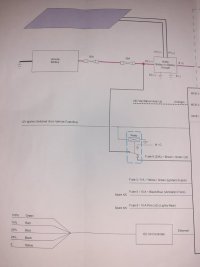Hi
Firstly forgive my lack of knowledge of electrics, but i'll try and explain things as best I can.
I am looking for some advice before going back to my convertor about an issue we have with the Wallas XC Duo and battery voltage. Our setup is Wallas hob/heater, fridge, lighting supported by a 12V 110AH SuperBatt LH110 leisure battery and 100w solar panel. Here's what happened on a recent trip and can be replicated as I did tonight.
We drive to a destination (1 hr +) off grid and in the evening we start the hob to cook dinner in the evening. It should be noted the fridge is on, but probably not cooling as it would already be cool and is on a low setting. A few lights would also be on. The voltage is sitting around 13.2 or 12.8 depending if there is any light outside for the solar. I start the Wallas hob as normal and you can see the voltage work its way down to about 12.1 during 5 mins or so as the heater begins the start up phase. After about 10 minutes or so once the hob has started and is producing heat, the voltage came back up to 12.5. I ran the heater for about an hour, which would be usual for cooking something and getting a bit of heat. I now switch off the heater and let it do the cool down. After about another hour I check the voltage and it shows around 12.3 with again two lights on, fridge likely idle. I start heater for some evening heat and after about 30 seconds to a minute I see the voltage go from 12.4 to 12.0 and the heater turns off, flashed yellow which is low voltage warning.
The heater/hob no longer works at all until we get some sunlight back in the morning, plug in to 240 or I haven't tried it but probably starting the engine for a while would help. Should I really need to do that? My question is, is this normal behaviour? Can I really only run the Wallas once and that's it? We did change out the battery for the same sort a few weeks back as we initially thought we had a duff battery, but the problems remain.
I see there are many people using the Wallas but I haven't really seen anyone complain about only being able to use it once per night. It leads me to believe we are either doing something wrong or have an electrical issue somewhere. What setups are you Wallas users using and how many times can you start the device while off grid at night or in the dark?
Thanks in advance.
Firstly forgive my lack of knowledge of electrics, but i'll try and explain things as best I can.
I am looking for some advice before going back to my convertor about an issue we have with the Wallas XC Duo and battery voltage. Our setup is Wallas hob/heater, fridge, lighting supported by a 12V 110AH SuperBatt LH110 leisure battery and 100w solar panel. Here's what happened on a recent trip and can be replicated as I did tonight.
We drive to a destination (1 hr +) off grid and in the evening we start the hob to cook dinner in the evening. It should be noted the fridge is on, but probably not cooling as it would already be cool and is on a low setting. A few lights would also be on. The voltage is sitting around 13.2 or 12.8 depending if there is any light outside for the solar. I start the Wallas hob as normal and you can see the voltage work its way down to about 12.1 during 5 mins or so as the heater begins the start up phase. After about 10 minutes or so once the hob has started and is producing heat, the voltage came back up to 12.5. I ran the heater for about an hour, which would be usual for cooking something and getting a bit of heat. I now switch off the heater and let it do the cool down. After about another hour I check the voltage and it shows around 12.3 with again two lights on, fridge likely idle. I start heater for some evening heat and after about 30 seconds to a minute I see the voltage go from 12.4 to 12.0 and the heater turns off, flashed yellow which is low voltage warning.
The heater/hob no longer works at all until we get some sunlight back in the morning, plug in to 240 or I haven't tried it but probably starting the engine for a while would help. Should I really need to do that? My question is, is this normal behaviour? Can I really only run the Wallas once and that's it? We did change out the battery for the same sort a few weeks back as we initially thought we had a duff battery, but the problems remain.
I see there are many people using the Wallas but I haven't really seen anyone complain about only being able to use it once per night. It leads me to believe we are either doing something wrong or have an electrical issue somewhere. What setups are you Wallas users using and how many times can you start the device while off grid at night or in the dark?
Thanks in advance.



